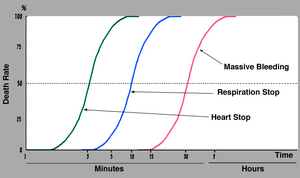

A window of opportunity, also called a margin of opportunity or critical window, is a period of time during which some action can be taken that will achieve a desired outcome. Once this period is over, or the "window is closed", the specified outcome is no longer possible.
Examples
Windows of opportunity include:
Biology and medicine
- The critical period in neurological development, during which neuroplasticity is greatest and key functions, such as imprinting and language, are acquired which may be impossible to acquire at a later stage
- The golden hour or golden time, used in emergency medicine to describe the period following traumatic injury in which life-saving treatment is most likely to be successful
Economics
- Market opportunities, in which one may be positioned to take advantage of a gap in a particular market, the timing of which may depend on the activities of customers, competitors, and other market context factors
- Limited time offer, a critical window for consumers that is artificially imposed (or even falsely implied) as a marketing tactic to encourage action
Other examples
- Planting and harvesting seasons, in agriculture, which are generally timed to maximize crop yields
- Space launch and maneuver windows, which are determined by orbital dynamics and mission goals and constrained by fuel/delta-v budgets
- The theorized tipping point in climatology, after which the Earth's climate is predicted to shift to a new stable equilibrium
- Various transient astronomical events, which present limited (and often unpredictable) windows for observation
Characteristics
Timing
The timing and length of a critical window may be well known and predictable (as in planetary transits) or more poorly understood (as in medical emergencies or climate change). In some cases, there may be multiple windows during which a goal can be achieved, as in the case of space launch windows.
In situations with very brief or unpredictable windows of opportunity, automation may be employed to take advantage of these windows, as in algorithmic trading and time-domain astronomy. Real-time computing systems can guarantee responses on the order of milliseconds or less.
Costs
In some time-critical situations, failure to act may entail an increasing cost over time, or a decreasing probability over time of achieving the desired outcome. In real-time computing systems, this may be represented by time-utility functions.
See also
- Planning
- Automated planning and scheduling, in artificial intelligence
- Point of no return
- Response time
- Target of opportunity, in combat
- Time limit
References
- "Illustration of a Short Gamma-Ray Burst Caused by a Collapsing Star". July 26, 2021. Retrieved August 3, 2021.
- "window of opportunity". Collins English Dictionary. Retrieved 19 July 2022.
- Robson, Ann L. "Critical/Sensitive Periods." Child Development. Ed. Neil J. Salkind. New York: Macmillan Reference USA, 2002. 101-103. Gale Virtual Reference Library. Web. 10 Dec. 2014.
- American College of Surgeons (2008). Atls, Advanced Trauma Life Support Program for Doctors. Amer College of Surgeons. ISBN 978-1880696316.
- "Window of Opportunity". Boundless.com. Retrieved 21 April 2016.
- "Window of Opportunity". Investopedia. Retrieved 21 April 2016.
- Sull, Donald N.; Wang, Yong (June 6, 2005). "The Three Windows of Opportunity". Working Knowledge. Harvard Business School. Retrieved 25 April 2016.
- Morrison, Maureen (July 22, 2014). "How to Create a Successful Limited-Time Offer: A Do's (and One Don't) Guide for Marketers to Short-Lived Promos". AdvertisingAge. Crain Communications. Retrieved 22 April 2016.
- Heiney, Anna (February 23, 2012). Ryba, Jeanne (ed.). "Aiming for an Open Window". NASA.gov. NASA Kennedy Space Center. Retrieved 22 April 2016.
- Wheeler, Robin (2009). "Apollo lunar landing launch window: The controlling factors and constraints". Apollo Flight Journal. Retrieved 22 April 2016.
- IPCC AR5 WGII (2014). "Climate change 2014, Impacts, Adaptation and Vulnerability" (PDF). Archived from the original (PDF) on 2015-05-14.
{{cite web}}: CS1 maint: numeric names: authors list (link) - "Time Domain Astronomy". Center for Astrophysics. Retrieved 19 July 2022.
- "Target of Opportunity Policies". European Southern Observatory. Retrieved 19 July 2022.
- Lin, Tom C. W. (2013). "The New Investor". UCLA Law Review. 60 (678). Temple University. SSRN 2227498.
- "Automated operations". Mission Operations Center for Swift. Pennsylvania State University. Retrieved 19 July 2022.
- Ben-Ari, M., "Principles of Concurrent and Distributed Programming", Prentice Hall, 1990. ISBN 0-13-711821-X. Ch16, Page 164